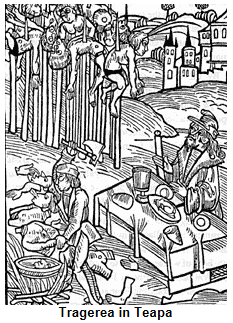The story of Vlad Tepes remains enveloped by mystery and legend, and the truth is that no one knows where the legend ends to leave the place of history.
Being a character not only historically but literary and folk, the voivode was chosen by writer Bram Stoker as the main hero of his novel in 1897. Since then, Dracula and Transylvania, the realm that houses the mysterious castle filled with ghosts and vampires somewhere in the middle of the dark forests, became the subject of over 750 films, documentaries or short stories inspired by the novel by the Irish writer.
There are many legends: one says that the transformation of Vlad Tepes into Count Dracula's blood is due to the fact that, according to the custom at that time, the winner of a fight would quench the band blood of the defeated.
Is this the truth about Dracula? Legend or history. Vlade Tepes was born in Sighisoara, Transylvania in 1431, later ruler of Wallachia. His father, Vlad Dracul, was a knight in the Order of the Dragon, a chivalrous order in Eastern Europe aimed at stopping the expansion of the Ottoman Empire.
The Dragon Order's Blaze was a dragon (Ottomans) and a cross (a sign of Christianity), and Vlad Dracul wore this symbol everywhere on flags, coins, and seals. His second son was Vlad II - DRACULA, the A at the end of the word "the devil" being a way of establishing his belonging - Dracula, the son of Dracul.
The nickname "Tepes" was attributed to him only after his death in 1476, because of his preferred way of punishment. Throwing in was a cruel way of execution, the victim being stabbed in a sharp, thick hair like a man's arm.
As a child, Vlad Tepes lived as a hostage of the Turks. While his family was assassinated, he was made aware of the torment he suffered. This seems to be the reason that he has poisoned his soul so that he became a voivode, the punishment of tainting, skinning, hanging, decapitating or shooting.  Famous for his intolerance and cruelty, Vlad was at the same time respected by his subjects for campaigning against the Turks. He was respected both as a warrior and as a voivode who did not tolerate injustice, during his reign lifting a few monasteries. He was an adult hero, and he was afraid of his people.
Famous for his intolerance and cruelty, Vlad was at the same time respected by his subjects for campaigning against the Turks. He was respected both as a warrior and as a voivode who did not tolerate injustice, during his reign lifting a few monasteries. He was an adult hero, and he was afraid of his people.
Victor Hugo in Legends of Siecles shows how Vlad Tepes welcomed the army of Sultan Mahomed II to conquer Wallachia. Moving to Targoviste, the Turkish army's soldiers were horrified by the view of Tepes: burned houses, paralyzed plains, and poisoned water fountains.
Everything culminated with the image near the walls of the fortress where Vlad the Impaler was sheltered: a huge forest of corpses. Feared and terrified by the smell of the 20,000 corpses of Turkish prisoners infected in the throne, Mahomet himself retired, recognizing the victory of the voivode.
For the Romans, Vlad Tepes remained the voivode during which you could drink water from the fountain of Targoviste Fortress with a large golden goblet without anyone stealing it (historical sources confirm the existence of this cup which was used until the day when Vlad Tepes he died).
Sort: Trending